A Feminist Analysis of Charlotte Perkins Gilman's The Yellow Wallpaper
VerifiedAdded on 2022/07/28
|9
|2300
|41
Essay
AI Summary
This essay provides a comprehensive analysis of Charlotte Perkins Gilman's short story, "The Yellow Wallpaper." It delves into the narrative, exploring the protagonist's descent into mental instability, likely stemming from postpartum depression and the restrictive societal norms of the 19th century. The essay examines the themes of feminism, madness, and the oppressive nature of patriarchal control, highlighting the protagonist's confinement, her husband's dismissive attitude towards her condition, and the symbolic significance of the yellow wallpaper itself. The analysis explores the story's gothic elements, the protagonist's growing obsession with the wallpaper, and her eventual breakdown as a form of resistance against societal expectations. The essay also considers the historical context, Gilman's personal experiences, and the story's impact on feminist literature, offering insights into the author's critique of medical practices and the limited roles assigned to women during that era. The essay also provides a look into feminist criticism and the evolution of the protagonist’s character in terms of her mental health and societal expectations.
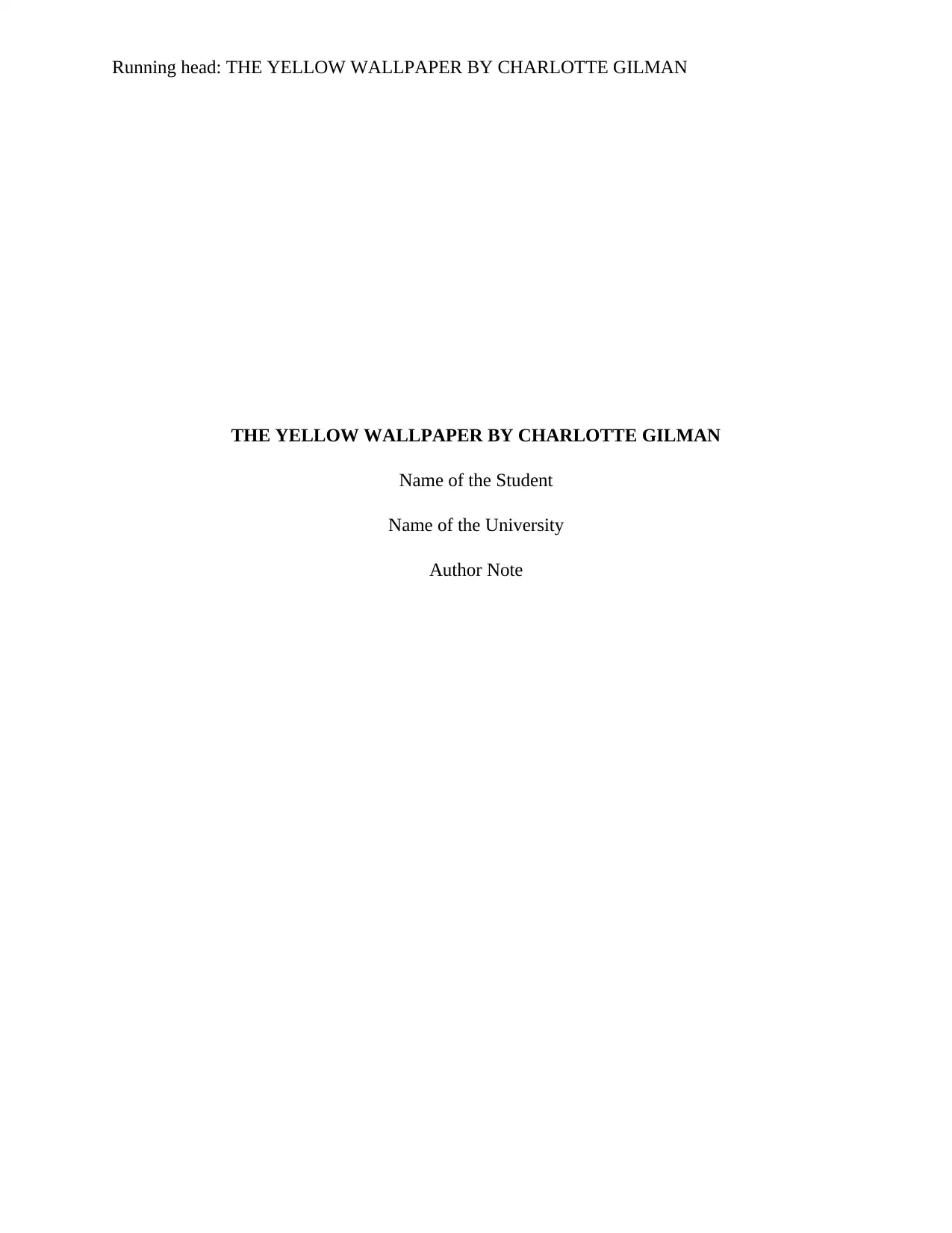
Running head: THE YELLOW WALLPAPER BY CHARLOTTE GILMAN
THE YELLOW WALLPAPER BY CHARLOTTE GILMAN
Name of the Student
Name of the University
Author Note
THE YELLOW WALLPAPER BY CHARLOTTE GILMAN
Name of the Student
Name of the University
Author Note
Paraphrase This Document
Need a fresh take? Get an instant paraphrase of this document with our AI Paraphraser
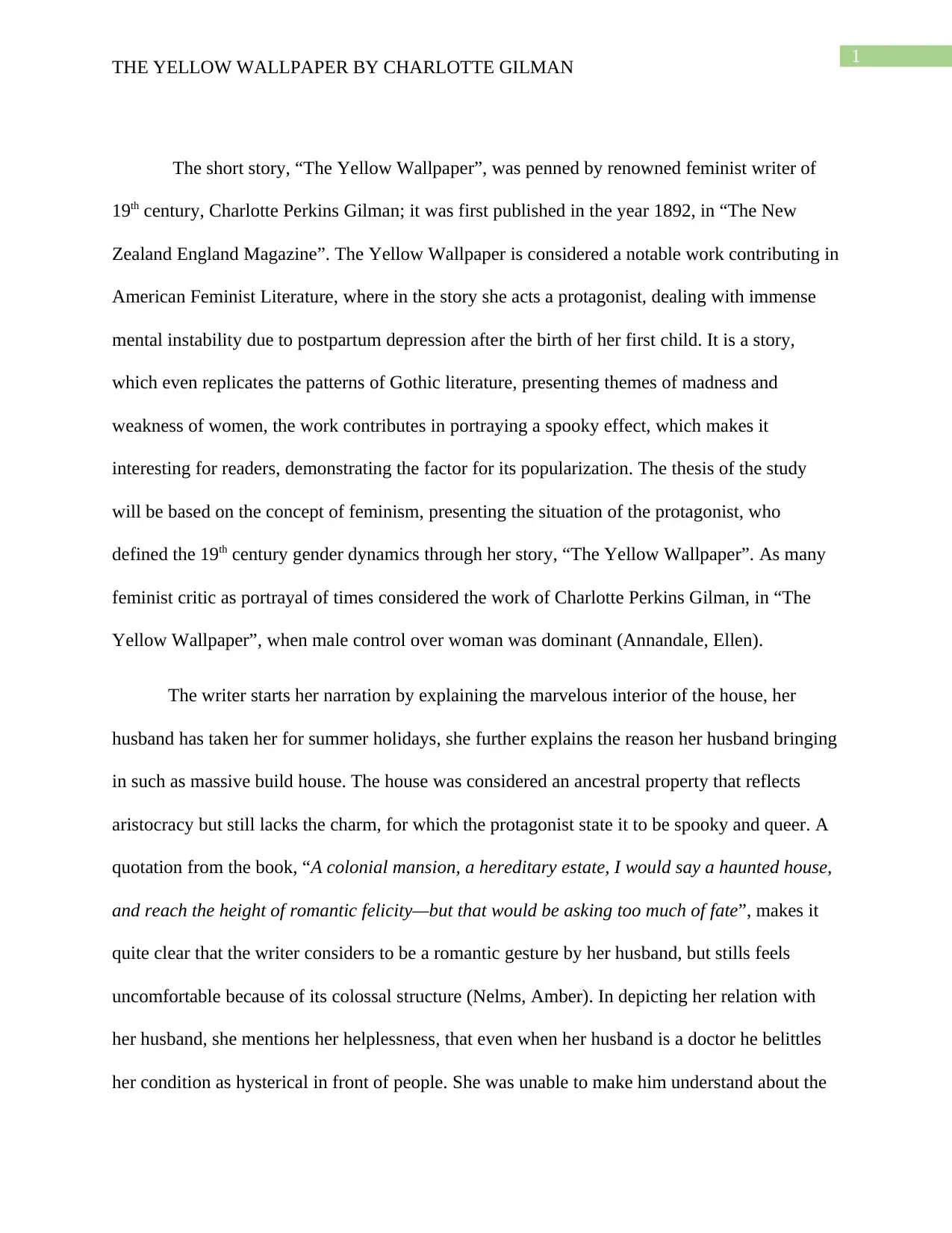
1
THE YELLOW WALLPAPER BY CHARLOTTE GILMAN
The short story, “The Yellow Wallpaper”, was penned by renowned feminist writer of
19th century, Charlotte Perkins Gilman; it was first published in the year 1892, in “The New
Zealand England Magazine”. The Yellow Wallpaper is considered a notable work contributing in
American Feminist Literature, where in the story she acts a protagonist, dealing with immense
mental instability due to postpartum depression after the birth of her first child. It is a story,
which even replicates the patterns of Gothic literature, presenting themes of madness and
weakness of women, the work contributes in portraying a spooky effect, which makes it
interesting for readers, demonstrating the factor for its popularization. The thesis of the study
will be based on the concept of feminism, presenting the situation of the protagonist, who
defined the 19th century gender dynamics through her story, “The Yellow Wallpaper”. As many
feminist critic as portrayal of times considered the work of Charlotte Perkins Gilman, in “The
Yellow Wallpaper”, when male control over woman was dominant (Annandale, Ellen).
The writer starts her narration by explaining the marvelous interior of the house, her
husband has taken her for summer holidays, she further explains the reason her husband bringing
in such as massive build house. The house was considered an ancestral property that reflects
aristocracy but still lacks the charm, for which the protagonist state it to be spooky and queer. A
quotation from the book, “A colonial mansion, a hereditary estate, I would say a haunted house,
and reach the height of romantic felicity—but that would be asking too much of fate”, makes it
quite clear that the writer considers to be a romantic gesture by her husband, but stills feels
uncomfortable because of its colossal structure (Nelms, Amber). In depicting her relation with
her husband, she mentions her helplessness, that even when her husband is a doctor he belittles
her condition as hysterical in front of people. She was unable to make him understand about the
THE YELLOW WALLPAPER BY CHARLOTTE GILMAN
The short story, “The Yellow Wallpaper”, was penned by renowned feminist writer of
19th century, Charlotte Perkins Gilman; it was first published in the year 1892, in “The New
Zealand England Magazine”. The Yellow Wallpaper is considered a notable work contributing in
American Feminist Literature, where in the story she acts a protagonist, dealing with immense
mental instability due to postpartum depression after the birth of her first child. It is a story,
which even replicates the patterns of Gothic literature, presenting themes of madness and
weakness of women, the work contributes in portraying a spooky effect, which makes it
interesting for readers, demonstrating the factor for its popularization. The thesis of the study
will be based on the concept of feminism, presenting the situation of the protagonist, who
defined the 19th century gender dynamics through her story, “The Yellow Wallpaper”. As many
feminist critic as portrayal of times considered the work of Charlotte Perkins Gilman, in “The
Yellow Wallpaper”, when male control over woman was dominant (Annandale, Ellen).
The writer starts her narration by explaining the marvelous interior of the house, her
husband has taken her for summer holidays, she further explains the reason her husband bringing
in such as massive build house. The house was considered an ancestral property that reflects
aristocracy but still lacks the charm, for which the protagonist state it to be spooky and queer. A
quotation from the book, “A colonial mansion, a hereditary estate, I would say a haunted house,
and reach the height of romantic felicity—but that would be asking too much of fate”, makes it
quite clear that the writer considers to be a romantic gesture by her husband, but stills feels
uncomfortable because of its colossal structure (Nelms, Amber). In depicting her relation with
her husband, she mentions her helplessness, that even when her husband is a doctor he belittles
her condition as hysterical in front of people. She was unable to make him understand about the
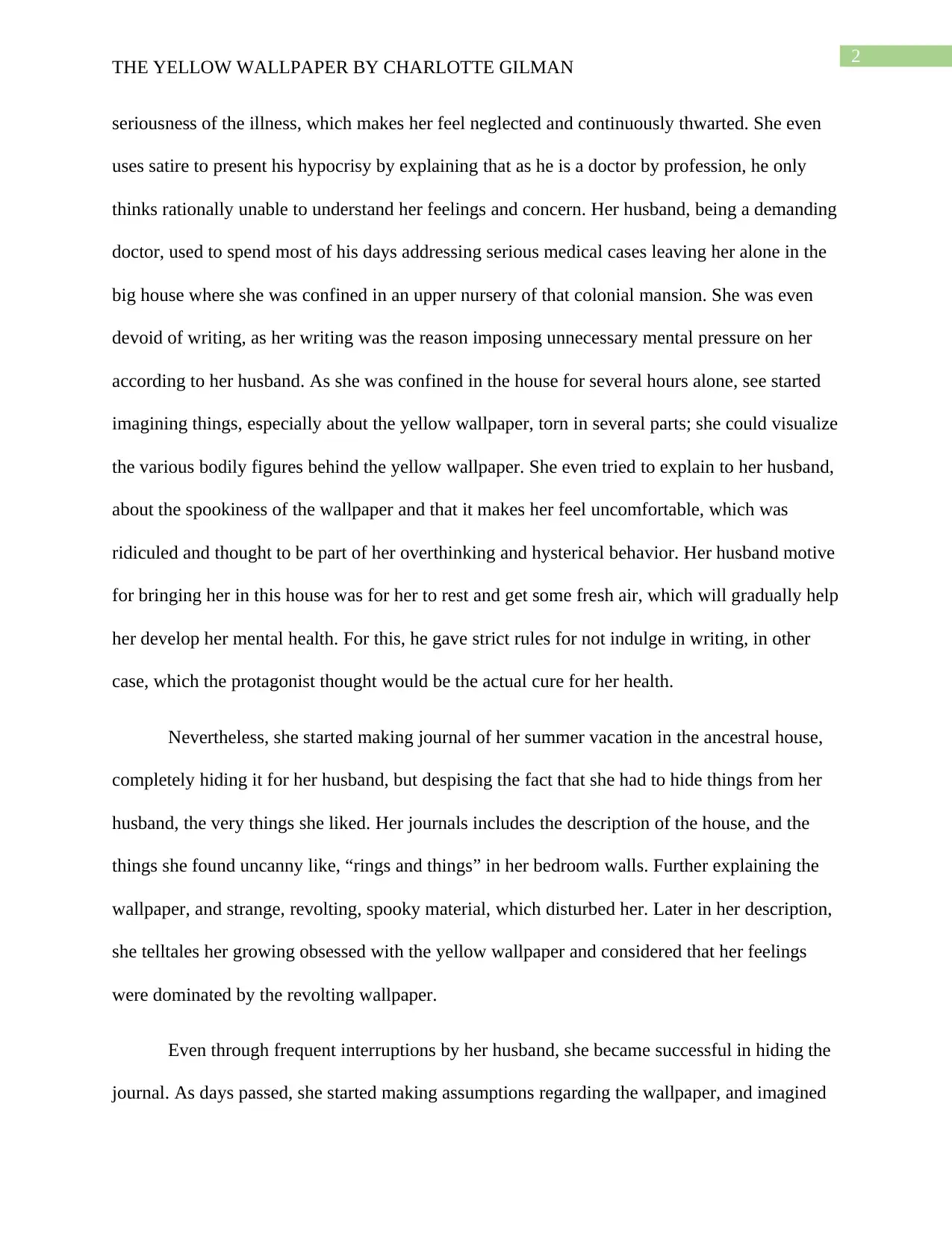
2
THE YELLOW WALLPAPER BY CHARLOTTE GILMAN
seriousness of the illness, which makes her feel neglected and continuously thwarted. She even
uses satire to present his hypocrisy by explaining that as he is a doctor by profession, he only
thinks rationally unable to understand her feelings and concern. Her husband, being a demanding
doctor, used to spend most of his days addressing serious medical cases leaving her alone in the
big house where she was confined in an upper nursery of that colonial mansion. She was even
devoid of writing, as her writing was the reason imposing unnecessary mental pressure on her
according to her husband. As she was confined in the house for several hours alone, see started
imagining things, especially about the yellow wallpaper, torn in several parts; she could visualize
the various bodily figures behind the yellow wallpaper. She even tried to explain to her husband,
about the spookiness of the wallpaper and that it makes her feel uncomfortable, which was
ridiculed and thought to be part of her overthinking and hysterical behavior. Her husband motive
for bringing her in this house was for her to rest and get some fresh air, which will gradually help
her develop her mental health. For this, he gave strict rules for not indulge in writing, in other
case, which the protagonist thought would be the actual cure for her health.
Nevertheless, she started making journal of her summer vacation in the ancestral house,
completely hiding it for her husband, but despising the fact that she had to hide things from her
husband, the very things she liked. Her journals includes the description of the house, and the
things she found uncanny like, “rings and things” in her bedroom walls. Further explaining the
wallpaper, and strange, revolting, spooky material, which disturbed her. Later in her description,
she telltales her growing obsessed with the yellow wallpaper and considered that her feelings
were dominated by the revolting wallpaper.
Even through frequent interruptions by her husband, she became successful in hiding the
journal. As days passed, she started making assumptions regarding the wallpaper, and imagined
THE YELLOW WALLPAPER BY CHARLOTTE GILMAN
seriousness of the illness, which makes her feel neglected and continuously thwarted. She even
uses satire to present his hypocrisy by explaining that as he is a doctor by profession, he only
thinks rationally unable to understand her feelings and concern. Her husband, being a demanding
doctor, used to spend most of his days addressing serious medical cases leaving her alone in the
big house where she was confined in an upper nursery of that colonial mansion. She was even
devoid of writing, as her writing was the reason imposing unnecessary mental pressure on her
according to her husband. As she was confined in the house for several hours alone, see started
imagining things, especially about the yellow wallpaper, torn in several parts; she could visualize
the various bodily figures behind the yellow wallpaper. She even tried to explain to her husband,
about the spookiness of the wallpaper and that it makes her feel uncomfortable, which was
ridiculed and thought to be part of her overthinking and hysterical behavior. Her husband motive
for bringing her in this house was for her to rest and get some fresh air, which will gradually help
her develop her mental health. For this, he gave strict rules for not indulge in writing, in other
case, which the protagonist thought would be the actual cure for her health.
Nevertheless, she started making journal of her summer vacation in the ancestral house,
completely hiding it for her husband, but despising the fact that she had to hide things from her
husband, the very things she liked. Her journals includes the description of the house, and the
things she found uncanny like, “rings and things” in her bedroom walls. Further explaining the
wallpaper, and strange, revolting, spooky material, which disturbed her. Later in her description,
she telltales her growing obsessed with the yellow wallpaper and considered that her feelings
were dominated by the revolting wallpaper.
Even through frequent interruptions by her husband, she became successful in hiding the
journal. As days passed, she started making assumptions regarding the wallpaper, and imagined
⊘ This is a preview!⊘
Do you want full access?
Subscribe today to unlock all pages.

Trusted by 1+ million students worldwide
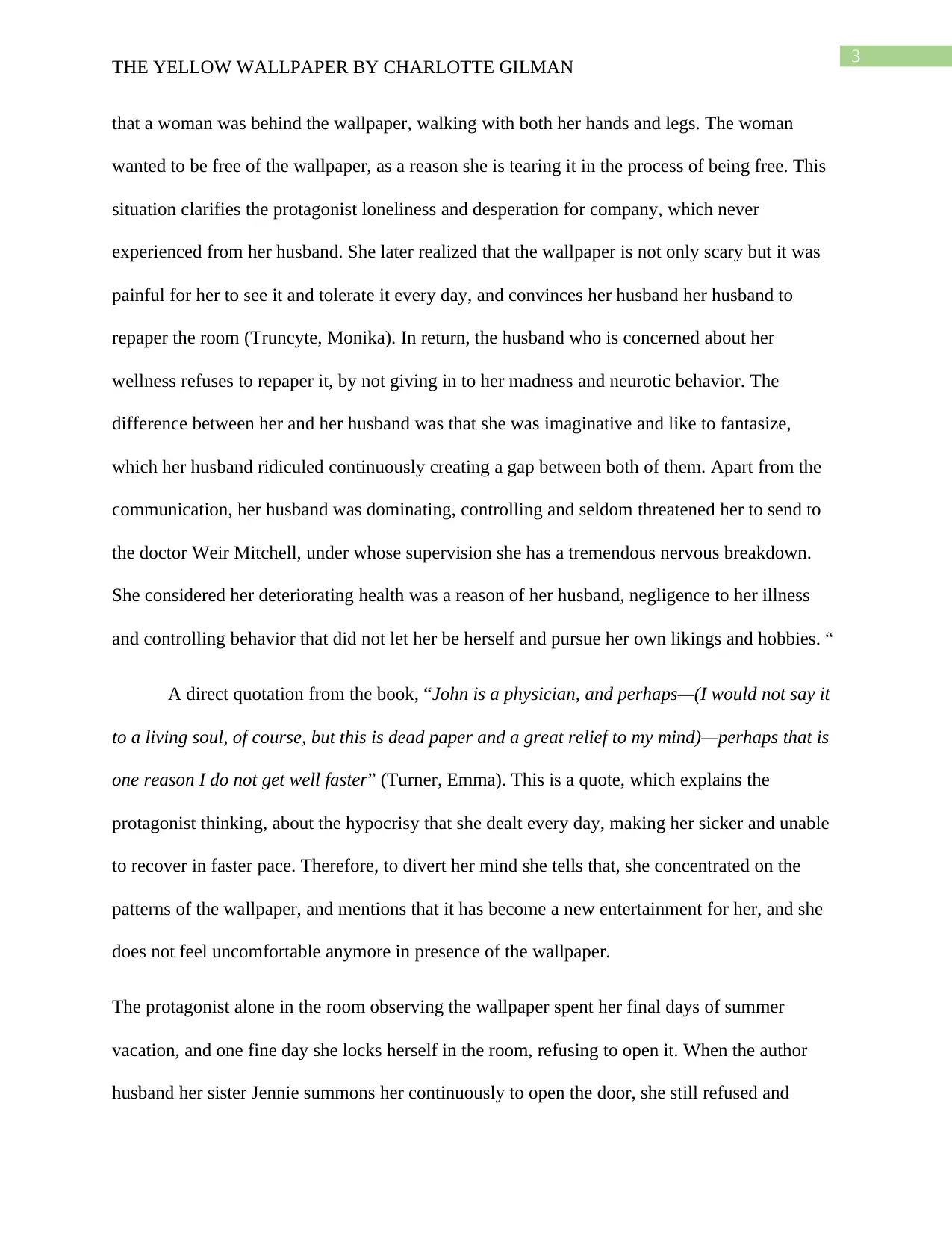
3
THE YELLOW WALLPAPER BY CHARLOTTE GILMAN
that a woman was behind the wallpaper, walking with both her hands and legs. The woman
wanted to be free of the wallpaper, as a reason she is tearing it in the process of being free. This
situation clarifies the protagonist loneliness and desperation for company, which never
experienced from her husband. She later realized that the wallpaper is not only scary but it was
painful for her to see it and tolerate it every day, and convinces her husband her husband to
repaper the room (Truncyte, Monika). In return, the husband who is concerned about her
wellness refuses to repaper it, by not giving in to her madness and neurotic behavior. The
difference between her and her husband was that she was imaginative and like to fantasize,
which her husband ridiculed continuously creating a gap between both of them. Apart from the
communication, her husband was dominating, controlling and seldom threatened her to send to
the doctor Weir Mitchell, under whose supervision she has a tremendous nervous breakdown.
She considered her deteriorating health was a reason of her husband, negligence to her illness
and controlling behavior that did not let her be herself and pursue her own likings and hobbies. “
A direct quotation from the book, “John is a physician, and perhaps—(I would not say it
to a living soul, of course, but this is dead paper and a great relief to my mind)—perhaps that is
one reason I do not get well faster” (Turner, Emma). This is a quote, which explains the
protagonist thinking, about the hypocrisy that she dealt every day, making her sicker and unable
to recover in faster pace. Therefore, to divert her mind she tells that, she concentrated on the
patterns of the wallpaper, and mentions that it has become a new entertainment for her, and she
does not feel uncomfortable anymore in presence of the wallpaper.
The protagonist alone in the room observing the wallpaper spent her final days of summer
vacation, and one fine day she locks herself in the room, refusing to open it. When the author
husband her sister Jennie summons her continuously to open the door, she still refused and
THE YELLOW WALLPAPER BY CHARLOTTE GILMAN
that a woman was behind the wallpaper, walking with both her hands and legs. The woman
wanted to be free of the wallpaper, as a reason she is tearing it in the process of being free. This
situation clarifies the protagonist loneliness and desperation for company, which never
experienced from her husband. She later realized that the wallpaper is not only scary but it was
painful for her to see it and tolerate it every day, and convinces her husband her husband to
repaper the room (Truncyte, Monika). In return, the husband who is concerned about her
wellness refuses to repaper it, by not giving in to her madness and neurotic behavior. The
difference between her and her husband was that she was imaginative and like to fantasize,
which her husband ridiculed continuously creating a gap between both of them. Apart from the
communication, her husband was dominating, controlling and seldom threatened her to send to
the doctor Weir Mitchell, under whose supervision she has a tremendous nervous breakdown.
She considered her deteriorating health was a reason of her husband, negligence to her illness
and controlling behavior that did not let her be herself and pursue her own likings and hobbies. “
A direct quotation from the book, “John is a physician, and perhaps—(I would not say it
to a living soul, of course, but this is dead paper and a great relief to my mind)—perhaps that is
one reason I do not get well faster” (Turner, Emma). This is a quote, which explains the
protagonist thinking, about the hypocrisy that she dealt every day, making her sicker and unable
to recover in faster pace. Therefore, to divert her mind she tells that, she concentrated on the
patterns of the wallpaper, and mentions that it has become a new entertainment for her, and she
does not feel uncomfortable anymore in presence of the wallpaper.
The protagonist alone in the room observing the wallpaper spent her final days of summer
vacation, and one fine day she locks herself in the room, refusing to open it. When the author
husband her sister Jennie summons her continuously to open the door, she still refused and
Paraphrase This Document
Need a fresh take? Get an instant paraphrase of this document with our AI Paraphraser
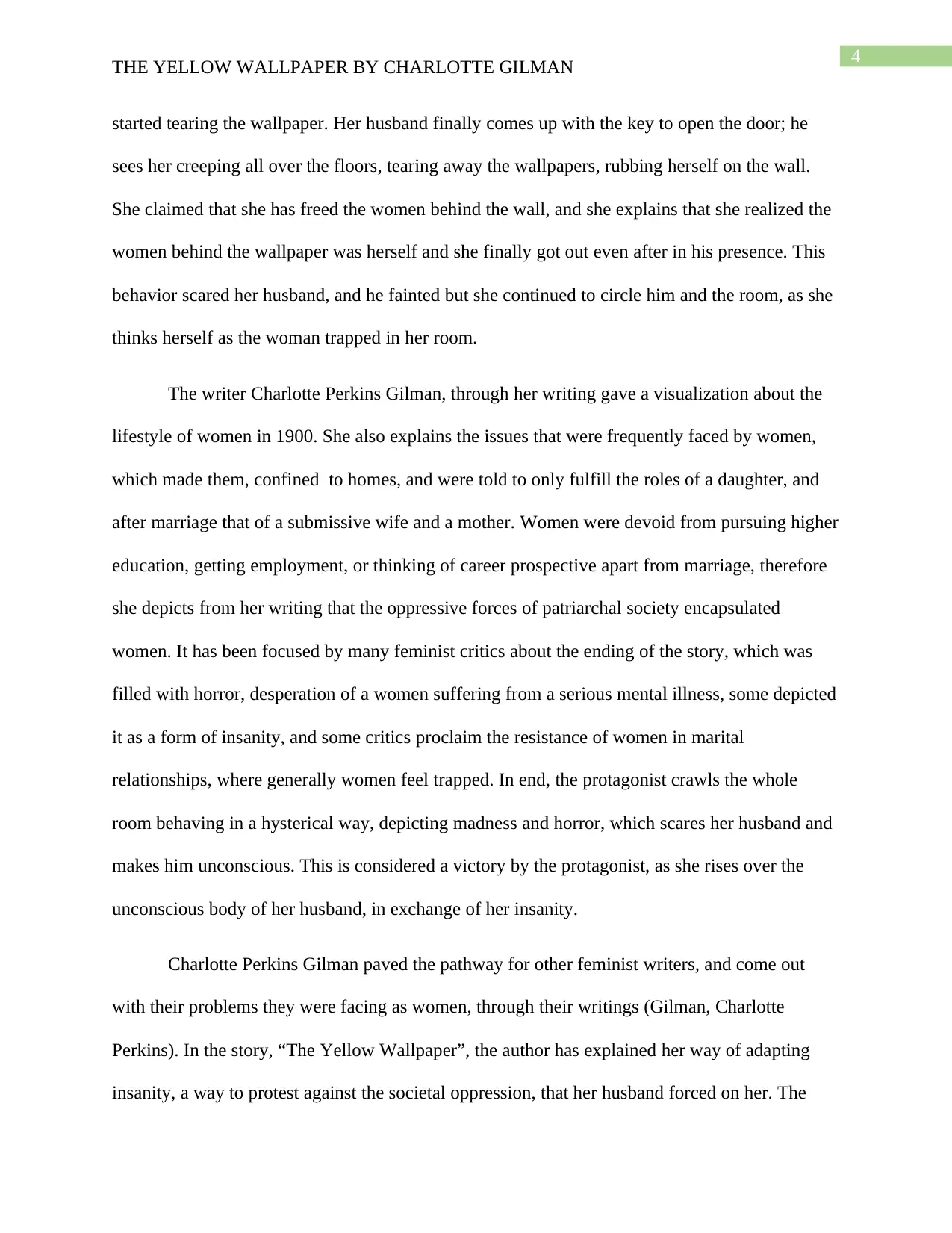
4
THE YELLOW WALLPAPER BY CHARLOTTE GILMAN
started tearing the wallpaper. Her husband finally comes up with the key to open the door; he
sees her creeping all over the floors, tearing away the wallpapers, rubbing herself on the wall.
She claimed that she has freed the women behind the wall, and she explains that she realized the
women behind the wallpaper was herself and she finally got out even after in his presence. This
behavior scared her husband, and he fainted but she continued to circle him and the room, as she
thinks herself as the woman trapped in her room.
The writer Charlotte Perkins Gilman, through her writing gave a visualization about the
lifestyle of women in 1900. She also explains the issues that were frequently faced by women,
which made them, confined to homes, and were told to only fulfill the roles of a daughter, and
after marriage that of a submissive wife and a mother. Women were devoid from pursuing higher
education, getting employment, or thinking of career prospective apart from marriage, therefore
she depicts from her writing that the oppressive forces of patriarchal society encapsulated
women. It has been focused by many feminist critics about the ending of the story, which was
filled with horror, desperation of a women suffering from a serious mental illness, some depicted
it as a form of insanity, and some critics proclaim the resistance of women in marital
relationships, where generally women feel trapped. In end, the protagonist crawls the whole
room behaving in a hysterical way, depicting madness and horror, which scares her husband and
makes him unconscious. This is considered a victory by the protagonist, as she rises over the
unconscious body of her husband, in exchange of her insanity.
Charlotte Perkins Gilman paved the pathway for other feminist writers, and come out
with their problems they were facing as women, through their writings (Gilman, Charlotte
Perkins). In the story, “The Yellow Wallpaper”, the author has explained her way of adapting
insanity, a way to protest against the societal oppression, that her husband forced on her. The
THE YELLOW WALLPAPER BY CHARLOTTE GILMAN
started tearing the wallpaper. Her husband finally comes up with the key to open the door; he
sees her creeping all over the floors, tearing away the wallpapers, rubbing herself on the wall.
She claimed that she has freed the women behind the wall, and she explains that she realized the
women behind the wallpaper was herself and she finally got out even after in his presence. This
behavior scared her husband, and he fainted but she continued to circle him and the room, as she
thinks herself as the woman trapped in her room.
The writer Charlotte Perkins Gilman, through her writing gave a visualization about the
lifestyle of women in 1900. She also explains the issues that were frequently faced by women,
which made them, confined to homes, and were told to only fulfill the roles of a daughter, and
after marriage that of a submissive wife and a mother. Women were devoid from pursuing higher
education, getting employment, or thinking of career prospective apart from marriage, therefore
she depicts from her writing that the oppressive forces of patriarchal society encapsulated
women. It has been focused by many feminist critics about the ending of the story, which was
filled with horror, desperation of a women suffering from a serious mental illness, some depicted
it as a form of insanity, and some critics proclaim the resistance of women in marital
relationships, where generally women feel trapped. In end, the protagonist crawls the whole
room behaving in a hysterical way, depicting madness and horror, which scares her husband and
makes him unconscious. This is considered a victory by the protagonist, as she rises over the
unconscious body of her husband, in exchange of her insanity.
Charlotte Perkins Gilman paved the pathway for other feminist writers, and come out
with their problems they were facing as women, through their writings (Gilman, Charlotte
Perkins). In the story, “The Yellow Wallpaper”, the author has explained her way of adapting
insanity, a way to protest against the societal oppression, that her husband forced on her. The
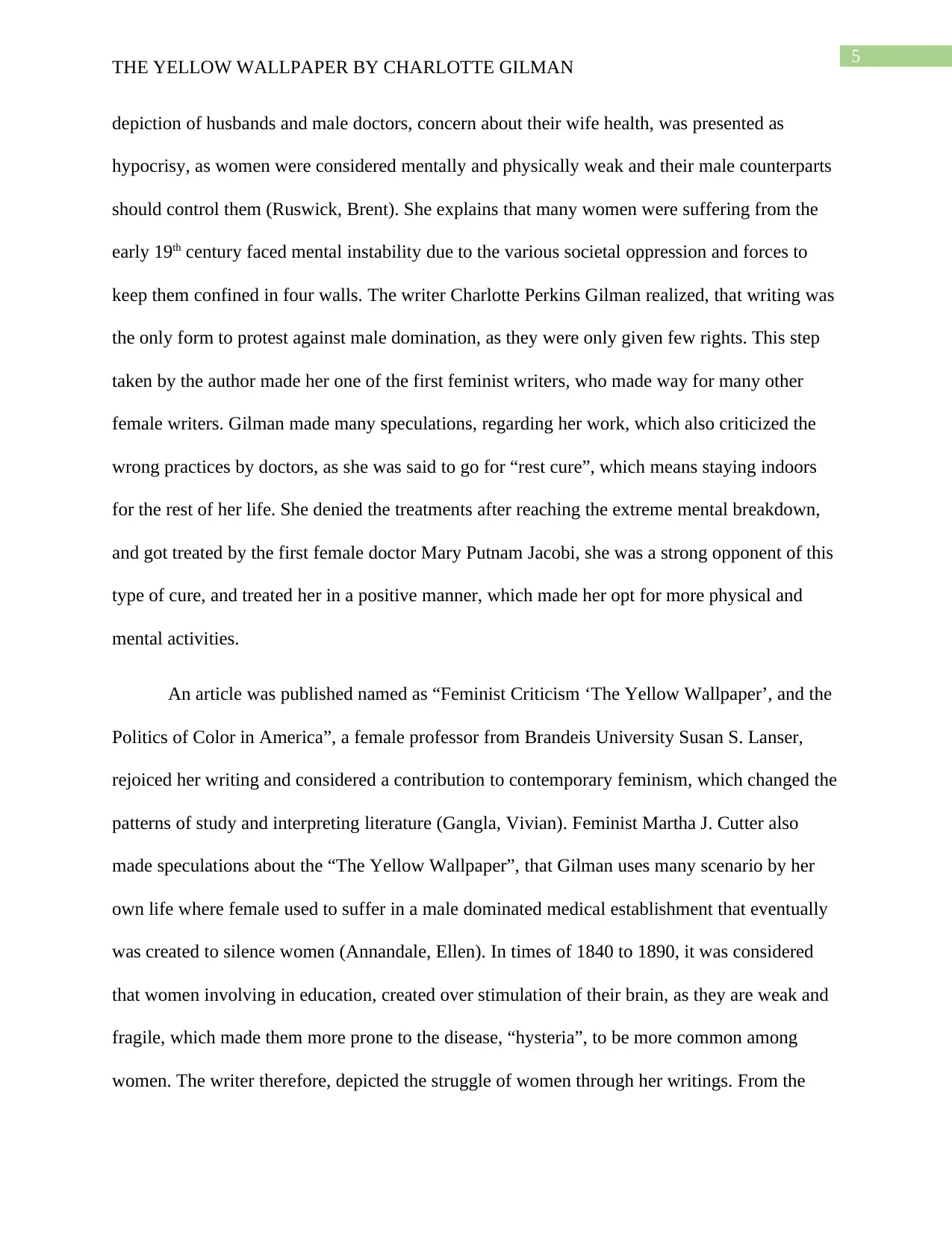
5
THE YELLOW WALLPAPER BY CHARLOTTE GILMAN
depiction of husbands and male doctors, concern about their wife health, was presented as
hypocrisy, as women were considered mentally and physically weak and their male counterparts
should control them (Ruswick, Brent). She explains that many women were suffering from the
early 19th century faced mental instability due to the various societal oppression and forces to
keep them confined in four walls. The writer Charlotte Perkins Gilman realized, that writing was
the only form to protest against male domination, as they were only given few rights. This step
taken by the author made her one of the first feminist writers, who made way for many other
female writers. Gilman made many speculations, regarding her work, which also criticized the
wrong practices by doctors, as she was said to go for “rest cure”, which means staying indoors
for the rest of her life. She denied the treatments after reaching the extreme mental breakdown,
and got treated by the first female doctor Mary Putnam Jacobi, she was a strong opponent of this
type of cure, and treated her in a positive manner, which made her opt for more physical and
mental activities.
An article was published named as “Feminist Criticism ‘The Yellow Wallpaper’, and the
Politics of Color in America”, a female professor from Brandeis University Susan S. Lanser,
rejoiced her writing and considered a contribution to contemporary feminism, which changed the
patterns of study and interpreting literature (Gangla, Vivian). Feminist Martha J. Cutter also
made speculations about the “The Yellow Wallpaper”, that Gilman uses many scenario by her
own life where female used to suffer in a male dominated medical establishment that eventually
was created to silence women (Annandale, Ellen). In times of 1840 to 1890, it was considered
that women involving in education, created over stimulation of their brain, as they are weak and
fragile, which made them more prone to the disease, “hysteria”, to be more common among
women. The writer therefore, depicted the struggle of women through her writings. From the
THE YELLOW WALLPAPER BY CHARLOTTE GILMAN
depiction of husbands and male doctors, concern about their wife health, was presented as
hypocrisy, as women were considered mentally and physically weak and their male counterparts
should control them (Ruswick, Brent). She explains that many women were suffering from the
early 19th century faced mental instability due to the various societal oppression and forces to
keep them confined in four walls. The writer Charlotte Perkins Gilman realized, that writing was
the only form to protest against male domination, as they were only given few rights. This step
taken by the author made her one of the first feminist writers, who made way for many other
female writers. Gilman made many speculations, regarding her work, which also criticized the
wrong practices by doctors, as she was said to go for “rest cure”, which means staying indoors
for the rest of her life. She denied the treatments after reaching the extreme mental breakdown,
and got treated by the first female doctor Mary Putnam Jacobi, she was a strong opponent of this
type of cure, and treated her in a positive manner, which made her opt for more physical and
mental activities.
An article was published named as “Feminist Criticism ‘The Yellow Wallpaper’, and the
Politics of Color in America”, a female professor from Brandeis University Susan S. Lanser,
rejoiced her writing and considered a contribution to contemporary feminism, which changed the
patterns of study and interpreting literature (Gangla, Vivian). Feminist Martha J. Cutter also
made speculations about the “The Yellow Wallpaper”, that Gilman uses many scenario by her
own life where female used to suffer in a male dominated medical establishment that eventually
was created to silence women (Annandale, Ellen). In times of 1840 to 1890, it was considered
that women involving in education, created over stimulation of their brain, as they are weak and
fragile, which made them more prone to the disease, “hysteria”, to be more common among
women. The writer therefore, depicted the struggle of women through her writings. From the
⊘ This is a preview!⊘
Do you want full access?
Subscribe today to unlock all pages.

Trusted by 1+ million students worldwide
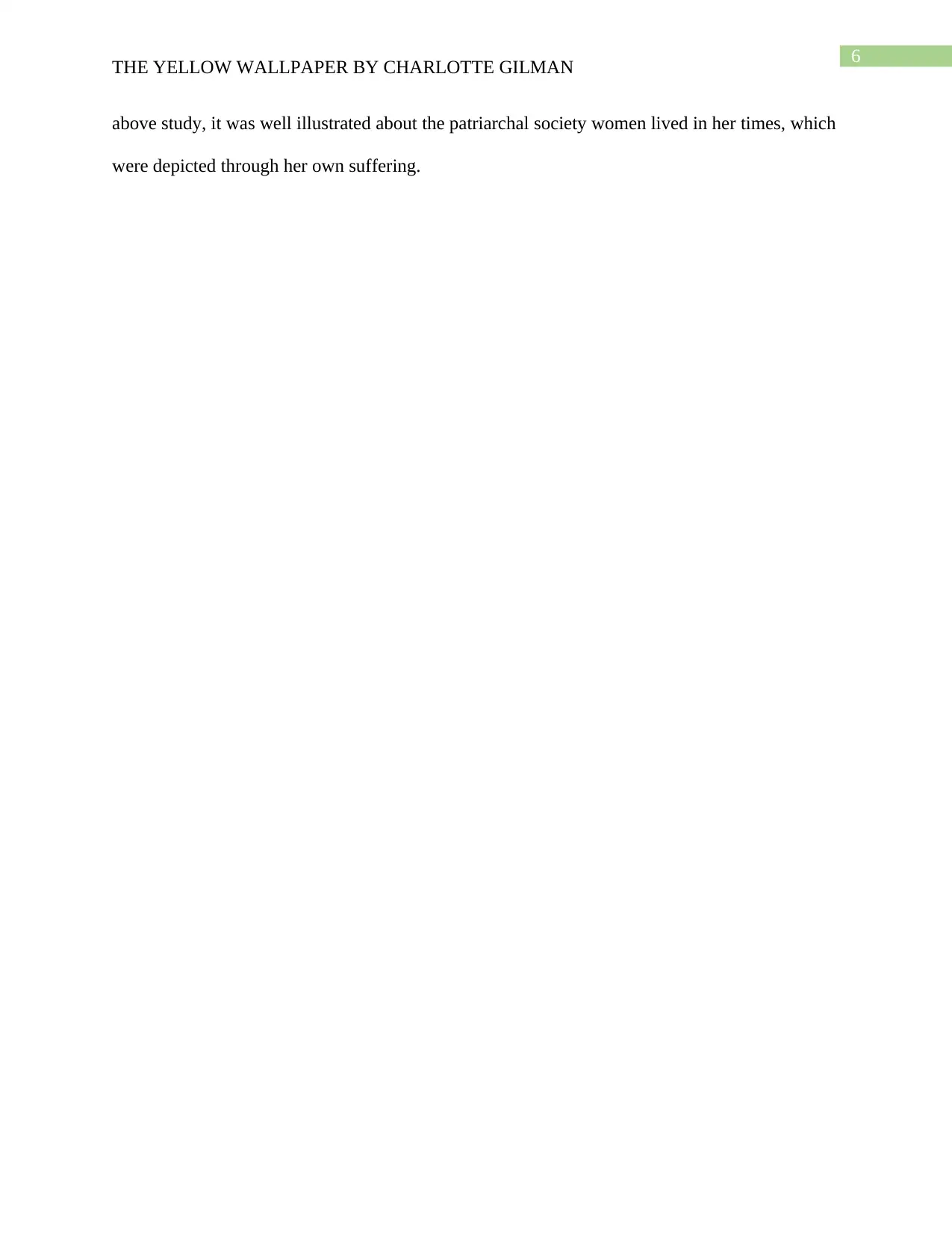
6
THE YELLOW WALLPAPER BY CHARLOTTE GILMAN
above study, it was well illustrated about the patriarchal society women lived in her times, which
were depicted through her own suffering.
THE YELLOW WALLPAPER BY CHARLOTTE GILMAN
above study, it was well illustrated about the patriarchal society women lived in her times, which
were depicted through her own suffering.
Paraphrase This Document
Need a fresh take? Get an instant paraphrase of this document with our AI Paraphraser
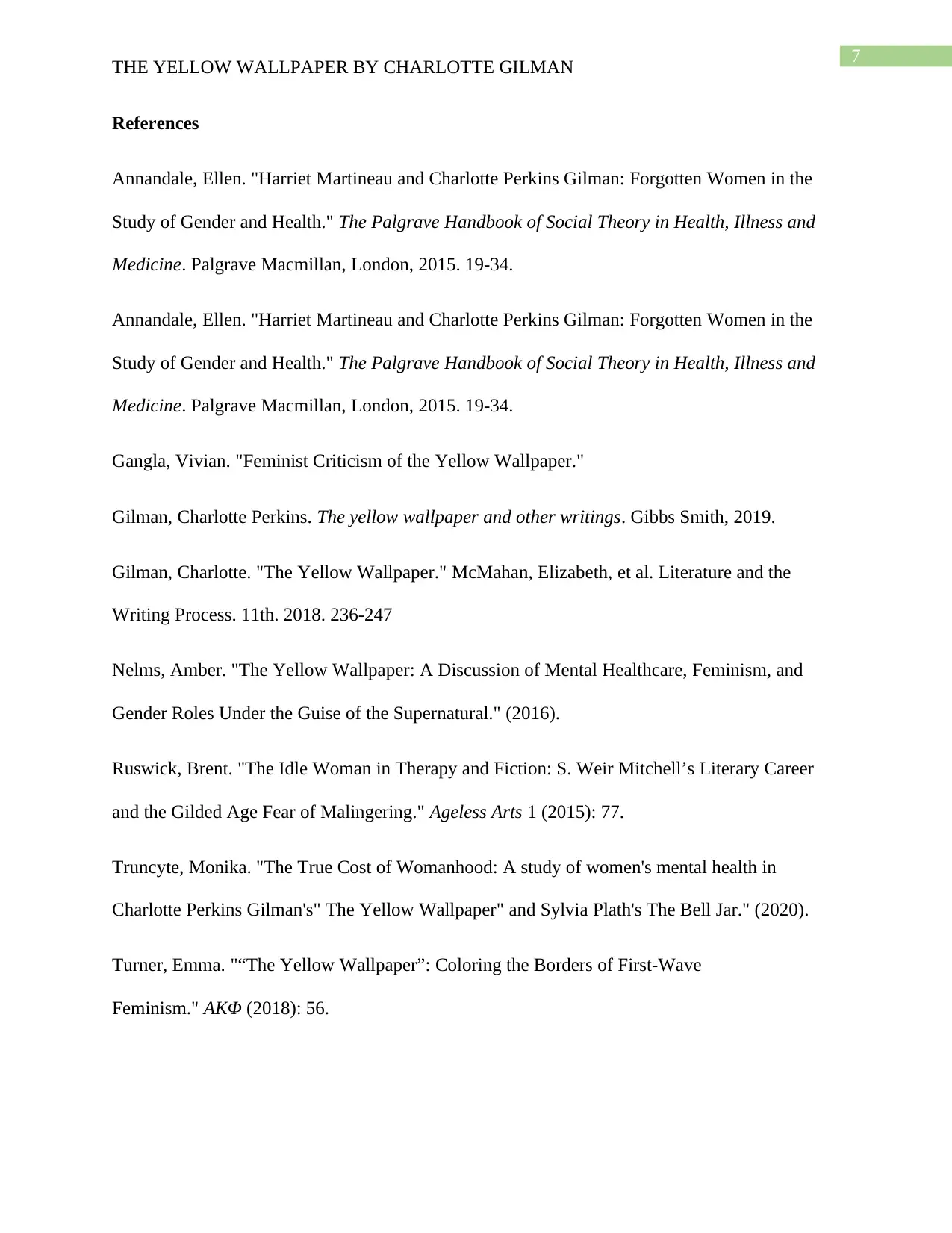
7
THE YELLOW WALLPAPER BY CHARLOTTE GILMAN
References
Annandale, Ellen. "Harriet Martineau and Charlotte Perkins Gilman: Forgotten Women in the
Study of Gender and Health." The Palgrave Handbook of Social Theory in Health, Illness and
Medicine. Palgrave Macmillan, London, 2015. 19-34.
Annandale, Ellen. "Harriet Martineau and Charlotte Perkins Gilman: Forgotten Women in the
Study of Gender and Health." The Palgrave Handbook of Social Theory in Health, Illness and
Medicine. Palgrave Macmillan, London, 2015. 19-34.
Gangla, Vivian. "Feminist Criticism of the Yellow Wallpaper."
Gilman, Charlotte Perkins. The yellow wallpaper and other writings. Gibbs Smith, 2019.
Gilman, Charlotte. "The Yellow Wallpaper." McMahan, Elizabeth, et al. Literature and the
Writing Process. 11th. 2018. 236-247
Nelms, Amber. "The Yellow Wallpaper: A Discussion of Mental Healthcare, Feminism, and
Gender Roles Under the Guise of the Supernatural." (2016).
Ruswick, Brent. "The Idle Woman in Therapy and Fiction: S. Weir Mitchell’s Literary Career
and the Gilded Age Fear of Malingering." Ageless Arts 1 (2015): 77.
Truncyte, Monika. "The True Cost of Womanhood: A study of women's mental health in
Charlotte Perkins Gilman's" The Yellow Wallpaper" and Sylvia Plath's The Bell Jar." (2020).
Turner, Emma. "“The Yellow Wallpaper”: Coloring the Borders of First-Wave
Feminism." ΑΚΦ (2018): 56.
THE YELLOW WALLPAPER BY CHARLOTTE GILMAN
References
Annandale, Ellen. "Harriet Martineau and Charlotte Perkins Gilman: Forgotten Women in the
Study of Gender and Health." The Palgrave Handbook of Social Theory in Health, Illness and
Medicine. Palgrave Macmillan, London, 2015. 19-34.
Annandale, Ellen. "Harriet Martineau and Charlotte Perkins Gilman: Forgotten Women in the
Study of Gender and Health." The Palgrave Handbook of Social Theory in Health, Illness and
Medicine. Palgrave Macmillan, London, 2015. 19-34.
Gangla, Vivian. "Feminist Criticism of the Yellow Wallpaper."
Gilman, Charlotte Perkins. The yellow wallpaper and other writings. Gibbs Smith, 2019.
Gilman, Charlotte. "The Yellow Wallpaper." McMahan, Elizabeth, et al. Literature and the
Writing Process. 11th. 2018. 236-247
Nelms, Amber. "The Yellow Wallpaper: A Discussion of Mental Healthcare, Feminism, and
Gender Roles Under the Guise of the Supernatural." (2016).
Ruswick, Brent. "The Idle Woman in Therapy and Fiction: S. Weir Mitchell’s Literary Career
and the Gilded Age Fear of Malingering." Ageless Arts 1 (2015): 77.
Truncyte, Monika. "The True Cost of Womanhood: A study of women's mental health in
Charlotte Perkins Gilman's" The Yellow Wallpaper" and Sylvia Plath's The Bell Jar." (2020).
Turner, Emma. "“The Yellow Wallpaper”: Coloring the Borders of First-Wave
Feminism." ΑΚΦ (2018): 56.

8
THE YELLOW WALLPAPER BY CHARLOTTE GILMAN
THE YELLOW WALLPAPER BY CHARLOTTE GILMAN
⊘ This is a preview!⊘
Do you want full access?
Subscribe today to unlock all pages.

Trusted by 1+ million students worldwide
1 out of 9
Related Documents
Your All-in-One AI-Powered Toolkit for Academic Success.
+13062052269
info@desklib.com
Available 24*7 on WhatsApp / Email
![[object Object]](/_next/static/media/star-bottom.7253800d.svg)
Unlock your academic potential
Copyright © 2020–2025 A2Z Services. All Rights Reserved. Developed and managed by ZUCOL.





